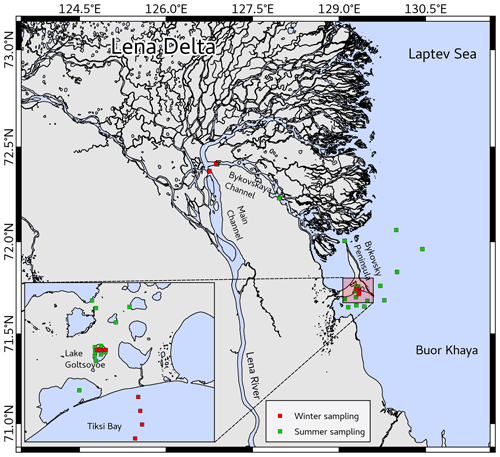Siberian scientists recently analysed how much methane was stored in the Lena River, Tiksi Bay and .Lake Golzovoye because methane levels in water are not as well known. Between 2001-17 the atmospheric methane increased to 1932 ppb, recorded at Tiksi Hydrometeorological Observatory.

They wanted to investigate the relationship between warmer water temperatures and increased methane in the atmosphere. With permafrost and ice, it is difficult to sample outside of ice-free periods. They also wanted to know more about methane oxidation under ice in lakes and test whether it reduces atmospheric methane when the ice thaws after winter. They completed core sampling in September 2016, April, July, August, 2017 and April 2018 at different sites in the Lena River area and Buor Khaya bay. To complement the samples, they investigated winter ice cores for methane levels.
They found higher concentrations from summer samples in the Lena river which continues to be affected by melting permafrost. Water continued to flow under the ice during the winter and conductivity was higher. In Lake Golzovoye, there were higher methane levels in the winter with the surface temperature cooler than the bottom of the lake, In summer the lake surface was warmer than the bottom. Tiksi bay was similar to Golzovoye with higher methane concentrations in the winter. Methane oxidation was highest in Lake Golzovoye, observable at 2°C, which also had lower flow rates and lower turbulence. They suggest this is one of the reasons for higher methane production.
The study does not refer to any anthropogenic activity there but the different water bodies are likely to affect atmosperic methane levels, depending on the changes in ice cover over the next few years.
A shortened time of ice coverage on the water bodies is predicted with increasing temperatures in the Arctic. With respect to our study this would imply a shortened time for methane to accumulate below the ice and a shorter time for the less efficient winter MOX. Especially for lakes, an extended time of ice-free conditions could reduce the methane flux from the Arctic water bodies.
Bussmann, I., Fedorova, I., Juhls, B., Overduin, P. P., and Winkel, M.(2021): Methane dynamics in three different Siberian water bodies under winter and summer conditions, Biogeosciences, 18, 2047–2061, https://doi.org/10.5194/bg-18-2047-2021
Bussmann, I., Fedorova, I., Juhls, B., Overduin, P. P., and Winkel, M.(2021): Methane dynamics in three different Siberian water bodies under winter and summer conditions, Biogeosciences, 18, 2047–2061, https://doi.org/10.5194/bg-18-2047-2021
